Top 10 Must-Visit Landmarks in Paris: Exploring the City of Lights
Paris, often referred to as the “City of Lights,” is a timeless destination that captivates travelers with its rich history, iconic architecture, and romantic ambiance. From historic monuments to modern wonders, the city offers an array of landmarks that are not only significant in their own right but also provide a glimpse into the heart and soul of Paris. Here are 10 must-visit landmarks that should be on every traveler’s itinerary:
1. Eiffel Tower: A Timeless Symbol
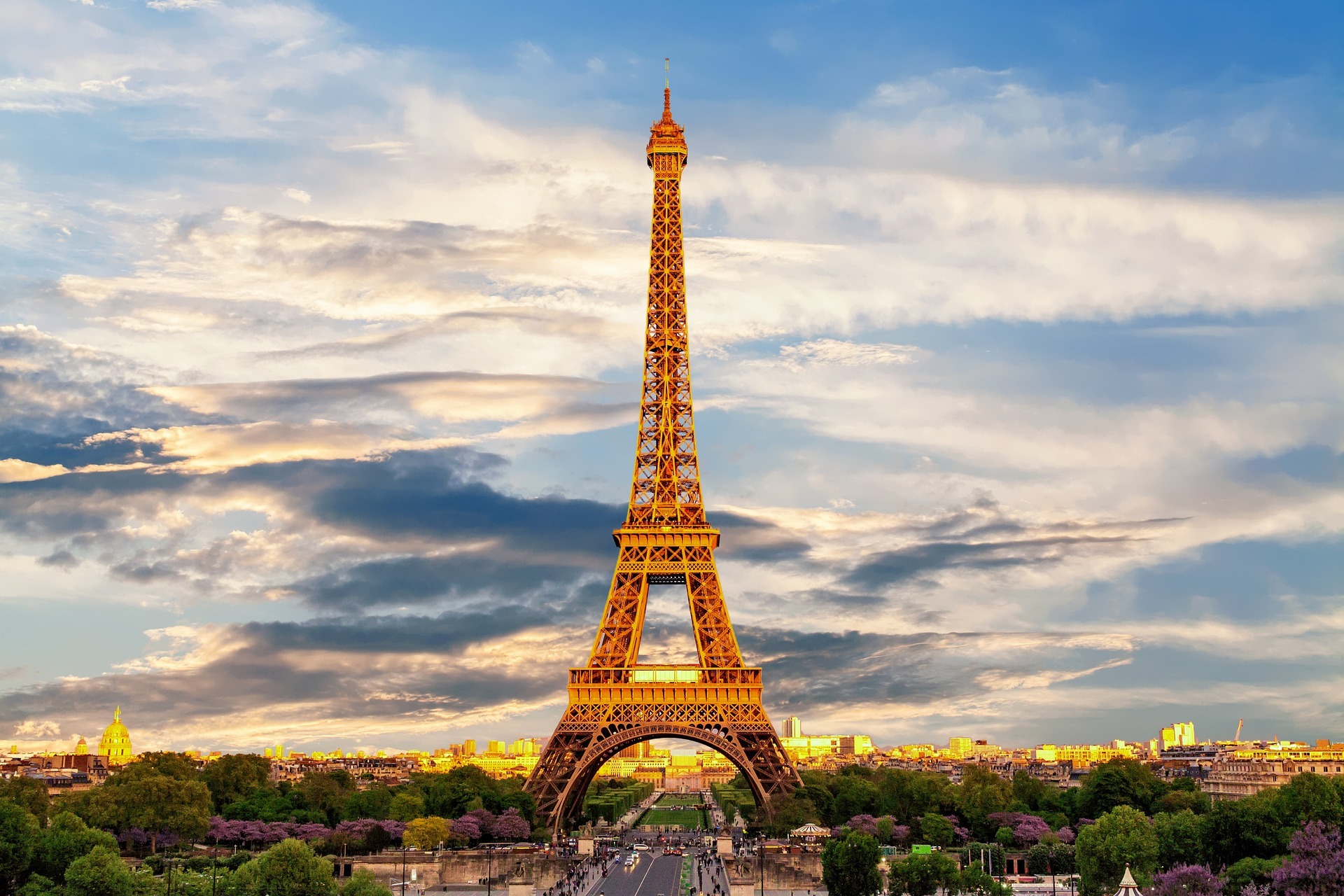
N1 – Must-Visit Landmarks in Paris – Eiffel Tower
No visit to Paris is complete without a trip to the Eiffel Tower. This iconic iron lattice structure stands as Must-Visit Landmarks in Paris aad a symbol of the city and offers breathtaking views from its observation decks. Whether you choose to admire it from below or ascend to its heights, the Eiffel Tower is a true masterpiece. Here are some compelling reasons why you should visit the Eiffel Tower:
Iconic Symbol:
The Eiffel Tower is not only an architectural wonder but also an internationally recognized symbol of Paris itself. It’s one of the most iconic landmarks in the world and holds a special place in the hearts of both Parisians and visitors.
Breathtaking Views:
The Eiffel Tower offers unparalleled panoramic views of the entire city. From its observation decks, you’ll be able to see some of Paris’s most famous landmarks, including the Louvre Museum, Notre-Dame Cathedral, and the Seine River. The view is especially enchanting during sunset and after dark when the city’s lights illuminate the skyline.
Historical Significance:
The tower has a rich history dating back to its construction for the 1889 World’s Fair, held in Paris to celebrate the 100th anniversary of the French Revolution. Learning about its origin and the challenges faced during its construction can deepen your appreciation for this engineering marvel.
Architectural Marvel:
Designed by Gustave Eiffel, the tower was a groundbreaking feat of engineering during its time. Its intricate iron lattice structure and the way it soars above the Parisian landscape were innovative and revolutionary. Understanding the architectural significance of the Eiffel Tower can be truly inspiring.
Cultural Experience:
The Eiffel Tower is not just a tourist attraction; it’s a cultural touchstone. It has been featured in countless films, literature, and artworks, making it a significant part of global pop culture. Being able to say you’ve visited this iconic site allows you to connect with a shared cultural experience.
Memorable Photography:
The Eiffel Tower provides a stunning backdrop for photographs. Whether you’re capturing the tower from below, taking a selfie with it, or trying to capture the perfect panoramic shot, your photos will be cherished memories of your time in Paris.
Romantic Atmosphere:
The Eiffel Tower’s romantic aura is undeniable. It’s a popular spot for couples and offers an ideal setting for proposals, romantic dinners, and romantic walks along the Seine River. The tower’s twinkling lights at night add an extra layer of enchantment.
Diverse Experiences:
The Eiffel Tower offers multiple experiences, from exploring its various levels to enjoying a meal at its renowned restaurant, Le 58 Tour Eiffel. Whether you’re looking for a casual visit or a more elevated experience, the tower caters to a range of preferences.
Bucket List Achievement:
For many travelers, visiting the Eiffel Tower is a bucket list item. It’s an opportunity to fulfill a dream and create lasting memories that you can share with friends and family.
The Eiffel Tower is not just a tourist attraction; it’s a symbol of beauty, history, and culture that encapsulates the essence of Paris. Whether you’re an architecture enthusiast, a romantic at heart, a history buff, or simply looking to capture stunning views, a visit to the Eiffel Tower promises an unforgettable experience that will stay with you long after you’ve left the City of Lights.
View and Book: Paris: Eiffel Tower Tour with Summit or 2nd Floor Access
2. Louvre Museum: Artistic Treasure Trove
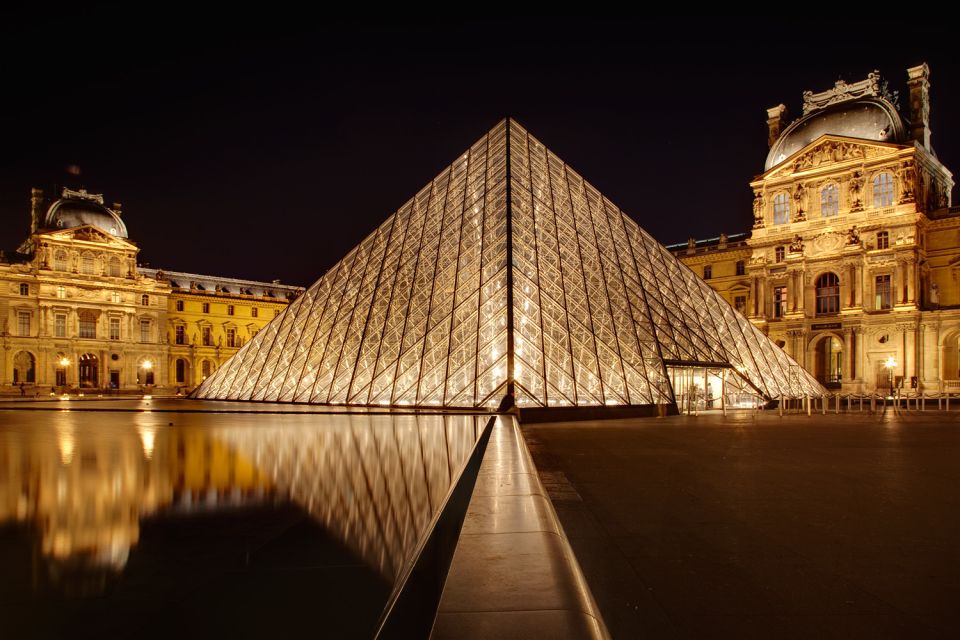
N2 – Must-Visit Landmarks in Paris – Louvre Museum
Home to thousands of years’ worth of art and history, the Louvre is a Must-Visit Landmarks in Paris and the world’s largest art museum. From the enigmatic smile of the Mona Lisa to the majestic Winged Victory of Samothrace, the Louvre’s collection is a journey through human creativity.
Iconic Artworks: Masterpieces That Define History
The Louvre houses an unparalleled collection of masterpieces from various time periods and cultures. You can come face to face with some of the most iconic artworks in history, including Leonardo da Vinci’s “Mona Lisa,” the ancient Greek statue “Venus de Milo,” and the monumental painting “Liberty Leading the People” by Eugène Delacroix.
Historical Significance: A Monument of the Ages
The museum is a historical monument in itself. Originally built as a medieval fortress, it evolved into a royal palace before becoming a public museum during the French Revolution. Its rich history is reflected in its architecture and layout.
Vast Collection: A Universe of Art Forms
With over 380,000 objects on display and a total collection of nearly one million works, the Louvre offers an extensive range of art forms, spanning painting, sculpture, decorative arts, and more. You can explore pieces from ancient civilizations, the Renaissance, the Enlightenment era, and beyond.
Artistic Diversity: A Global Showcase
The Louvre’s collection represents cultures from around the world. You can view artifacts from ancient Egypt, Mesopotamia, Greece, Rome, Asia, and the Americas, offering a global perspective on art and human history.
Architectural Marvel: Old Meets New
The Louvre’s architecture is a work of art itself. The glass pyramid entrance designed by architect I.M. Pei is a modern contrast to the historic structures, creating a fusion of old and new that reflects the museum’s dual identity.
Educational Experience: Learning Beyond Borders
The Louvre is an educational goldmine. Whether you’re an art enthusiast or a casual visitor, you can learn about different artistic movements, styles, and historical contexts. The museum offers guided tours, audio guides, and educational materials to enhance your understanding.
Cultural Exploration: A Timeless Journey
Exploring the Louvre is like embarking on a journey through time and cultures. You can witness the evolution of art and human creativity, gaining insight into how societies expressed themselves and interacted with their environments.
Inspiration and Awe: Immersed in Genius
The sheer magnitude of the artworks and the museum’s grandeur can be awe-inspiring. Walking through its halls surrounded by works of genius can ignite your own creativity and appreciation for beauty.
Cultural Legacy: Becoming a Part of History
By visiting the Louvre, you become a part of its legacy. You join the ranks of countless visitors, artists, and thinkers who have been influenced by the museum’s treasures.
Enriching Experience: Delving Deeper into Art
The Louvre offers a chance to engage with art on a deeper level. It encourages introspection, dialogue, and reflection, fostering a greater understanding of our shared human heritage.
In summary, a visit to the Louvre Museum is not just about seeing famous artworks; it’s about immersing yourself in a world of creativity, history, and culture. It’s an opportunity to connect with humanity’s artistic achievements and to be enriched by the diversity of human expression.
View and Book: Paris: Louvre Museum Timed-Entrance Ticket
3. Notre-Dame Cathedral: Gothic Grandeur
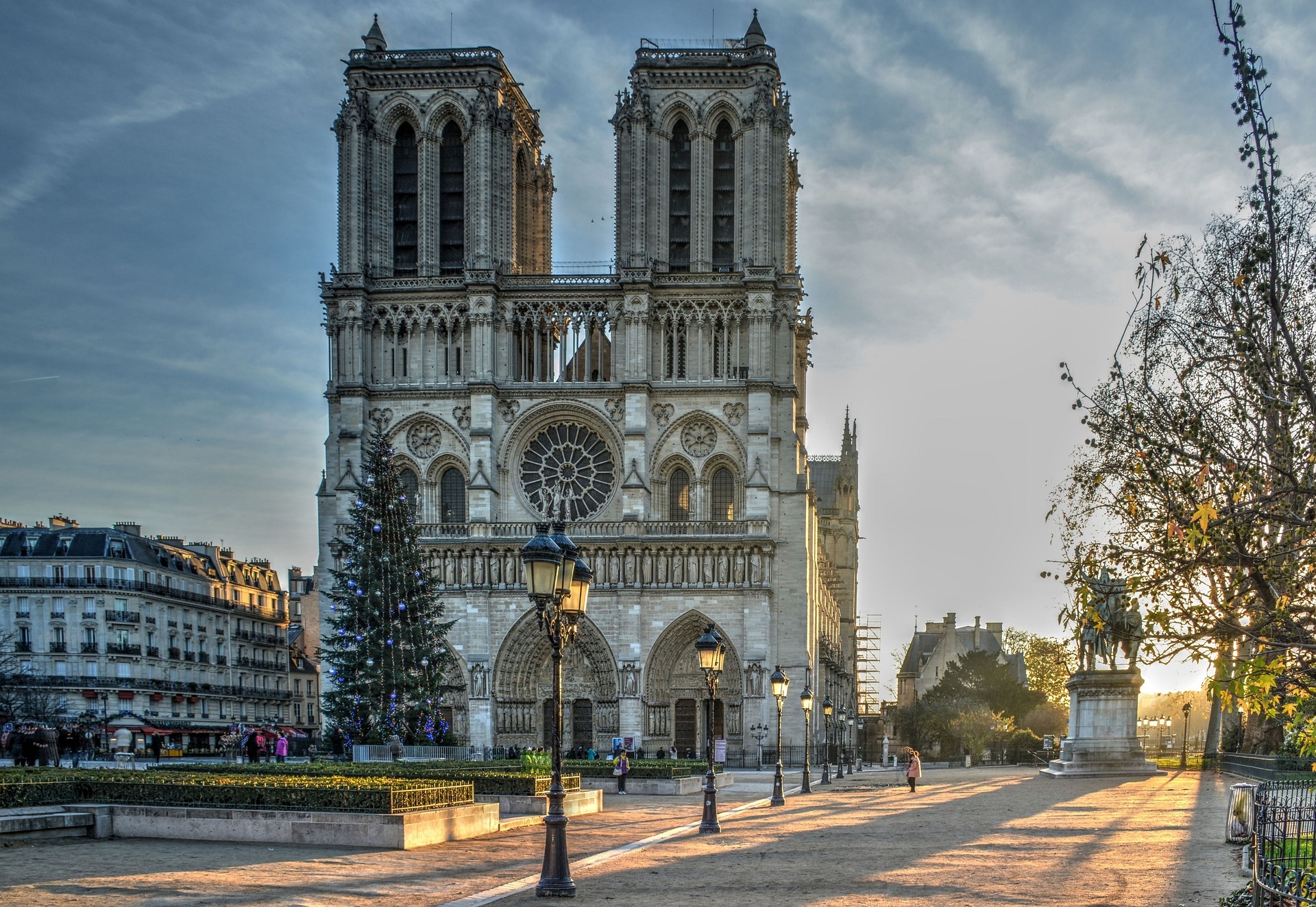
N3 – Must-Visit Landmarks in Paris – Notre-Dame – Image by Leif Linding
Visiting Notre-Dame Cathedral in Paris is an experience that offers a blend of historical significance, architectural marvel, and cultural resonance. Notre-Dame Cathedral is a Must-Visit Landmarks in Paris and here are several compelling reasons why you should consider a visit to this iconic landmark:
Architectural Splendor:
Notre-Dame Cathedral is a masterpiece of French Gothic architecture. Its intricate stone carvings, gargoyles, and flying buttresses showcase the craftsmanship and artistic genius of its time.
Historical Significance:
Witnessing events that have shaped both Paris and France, Notre-Dame Cathedral’s walls hold centuries of history, from its construction in the 12th century to coronations and significant ceremonies.
Spiritual and Cultural Center:
For centuries, Notre-Dame has been a place of worship and spiritual reflection. Its interior features stunning stained glass windows, intricate rose windows, and impressive sculptures that tell stories from Christian history.
Quasimodo and Victor Hugo’s “The Hunchback of Notre-Dame”:
The cathedral’s fame was solidified by Victor Hugo’s novel “The Hunchback of Notre-Dame.” Quasimodo and the cathedral itself have become cultural symbols, highlighting its historical and aesthetic importance.
Resilience and Restoration:
The 2019 fire emphasized Notre-Dame’s resilience and the dedication to restoring this architectural treasure. Visiting now allows you to witness ongoing restoration efforts and the commitment to preserving heritage.
Panoramic Views:
Ascending the towers of Notre-Dame offers unique panoramic views of Paris, including landmarks like the Eiffel Tower and Sacré-Cœur Basilica.
Location in Île de la Cité:
Situated on Île de la Cité, Notre-Dame’s central location provides easy access to historic Paris, landmarks like the Conciergerie and Sainte-Chapelle, and the vibrant Marais district.
Symbol of Unity:
The global support following the fire reaffirmed Notre-Dame’s role as a symbol of unity, culture, and shared heritage, inviting visitors to connect with its historical and cultural significance.
View and Book: Paris: Notre Dame Outdoor Walking Tour with Crypt Entry
4. Sacré-Cœur Basilica: A Hilltop Sanctuary
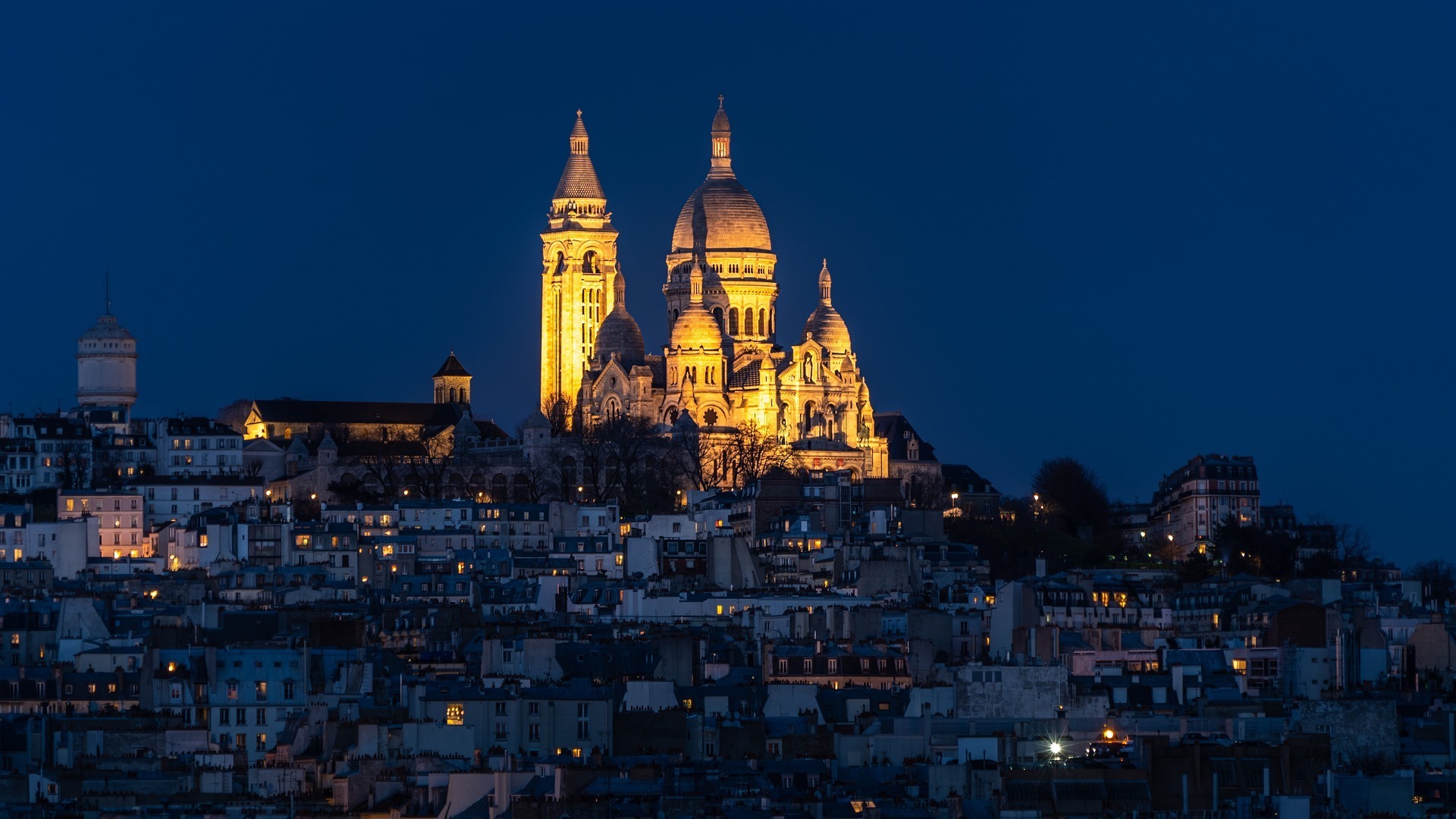
N4 – Must-Visit Landmarks in Paris – Sacré-Cœur Basilica- Image by Pierre Blaché
Perched atop Montmartre, the Sacré-Cœur Basilica offers panoramic views of Paris. The white-domed basilica’s Romanesque and Byzantine architecture is a sight to behold, and the surrounding Montmartre district exudes an artistic and bohemian vibe. Here’s why Sacré-Cœur Basilica is a must-Visit Landmarks in Paris:
Experience Spiritual Tranquility: A Hilltop Sanctuary
The Sacré-Cœur Basilica, perched majestically atop Montmartre, offers a serene escape from the bustling streets of Paris. Its elevated location provides a sense of spiritual tranquility, making it a perfect spot for reflection and contemplation.
Architectural Marvel: Romanesque and Byzantine Fusion
The basilica’s distinctive architecture is a harmonious blend of Romanesque and Byzantine styles. The white-domed structure with its intricate details stands as a remarkable example of artistic fusion, inviting admiration from architecture enthusiasts.
Breathtaking Panoramas: Unparalleled Views of Paris
Prepare to be captivated by breathtaking panoramic views of Paris from the basilica’s esplanade. The sweeping vistas showcase iconic landmarks, including the Eiffel Tower and Notre-Dame Cathedral, against the backdrop of the sprawling cityscape.
Historical Significance: A Symbol of National Unity
The Sacré-Cœur Basilica holds historical significance as a symbol of national unity and resilience. It was constructed in the late 19th century as a spiritual homage and a gesture of hope after the turmoil of the Franco-Prussian War and the Commune of Paris.
Artistic Beauty: Intricate Mosaics and Interior
Step inside the basilica to discover an interior adorned with intricate mosaics that depict religious scenes and motifs. The artistic beauty of the mosaics, combined with the gentle glow of the interior lighting, creates an atmosphere of reverence and awe.
Religious Devotion: A Place of Worship and Pilgrimage
The Sacré-Cœur Basilica serves as an active place of worship, drawing both locals and visitors who seek spiritual solace. Its central location on Montmartre also makes it a destination for pilgrims, adding to the profound sense of devotion that permeates the atmosphere.
Montmartre’s Charm: Surrounding Bohemian Vibes
Beyond the basilica itself, Montmartre exudes a charming and bohemian atmosphere that’s hard to resist. The district’s cobblestone streets, artistic heritage, and lively cafés offer an enchanting backdrop to your visit, making it a well-rounded experience.
Cultural Enrichment: Artistic Legacy and Performances
Montmartre has a rich artistic legacy, having been a hub for renowned artists like Picasso and Van Gogh. The area hosts street performances, art studios, and galleries, providing an opportunity to immerse yourself in Paris’s creative spirit.
Sunset Splendor: A Romantic Evening Retreat
Visiting the Sacré-Cœur Basilica at sunset is a romantic and unforgettable experience. As the sun dips below the horizon, the basilica’s domes and the cityscape are bathed in warm hues, creating a picturesque backdrop for couples and photographers alike.
Photographer’s Paradise: Capturing Timeless Moments
Whether you’re a professional photographer or an amateur with a smartphone, the Sacré-Cœur Basilica offers a wealth of photogenic angles. From the stunning exterior to the panoramic views, you’ll have the chance to capture truly timeless moments.
View and Book: Paris: Sacré-Coeur and Montmartre Tour with Expert Guide
5. The Arc de Triomphe Experience
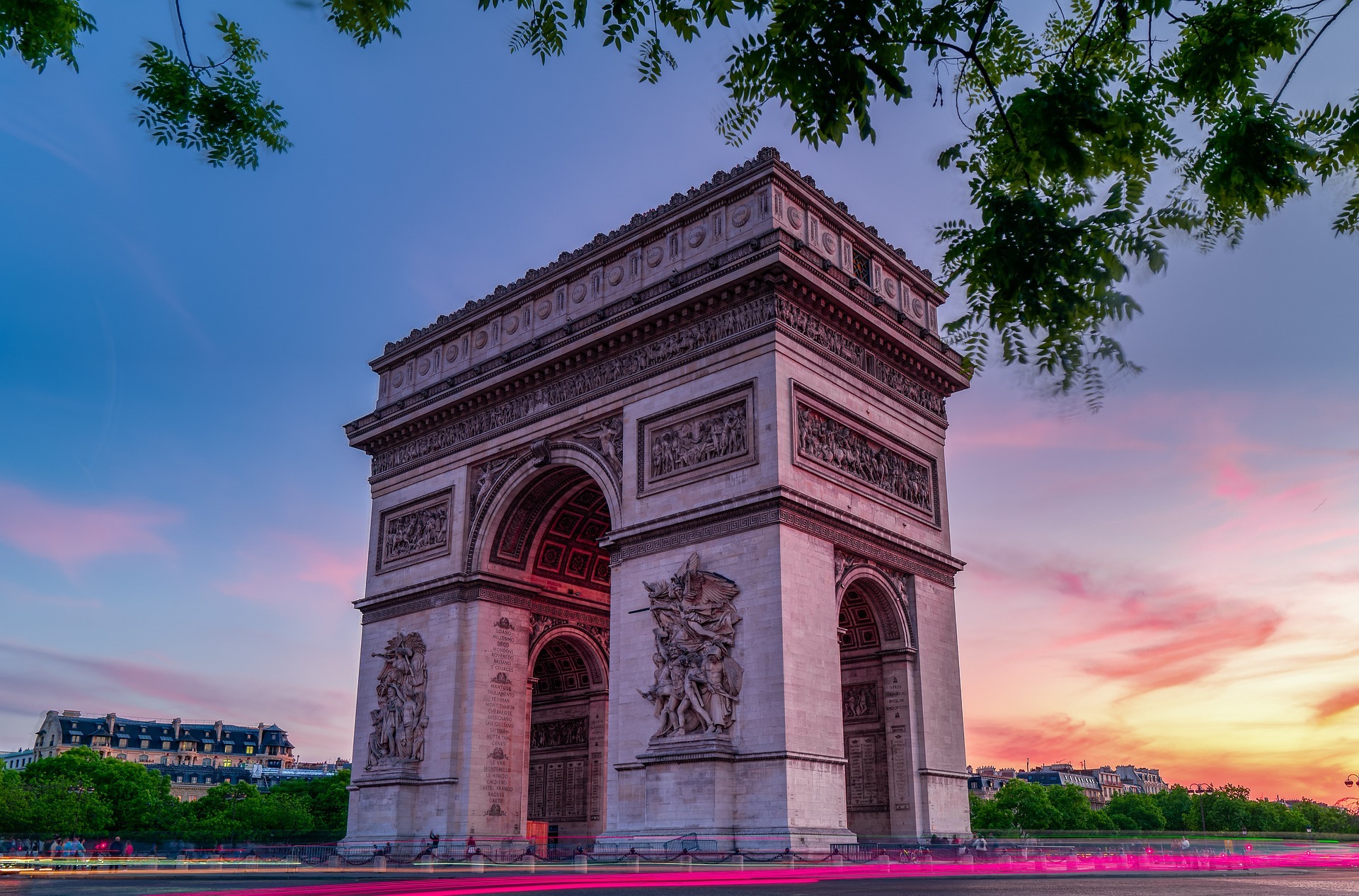
N5 – Must-Visit Landmarks in Paris – Arc de Triomphe in Paris
When it comes to iconic landmarks in Paris, the Arc de Triomphe stands tall as an enduring symbol of the city’s history, resilience, and grandeur. Perched majestically at the western end of the Champs-Élysées, this monumental arch is a testament to the triumphs and tribulations that have shaped France. A visit to the Arc de Triomphe is an absolute must for anyone seeking to delve into the heart of Parisian heritage.
A Historic Tribute to Courage and Sacrifice
The Arc de Triomphe was commissioned by Napoleon Bonaparte after his victory at Austerlitz in 1805, with the intention of commemorating the French army’s triumphs. However, the monument’s significance evolved over time to honor the soldiers who fought valiantly and paid the ultimate sacrifice during various wars. The Tomb of the Unknown Soldier beneath the arch is a poignant reminder of the nation’s gratitude and respect for those who gave their lives for France.
Architectural Splendor and Symbolism
Designed by Jean Chalgrin, the Arc de Triomphe is a masterpiece of neoclassical architecture. Its intricate reliefs, sculptures, and inscriptions tell the story of France’s military history and its commitment to liberty and freedom. The arch’s colossal size and meticulous detailing make it a captivating example of architectural grandeur that resonates with visitors from around the world.
Unparalleled Panoramic Views
One of the highlights of visiting the Arc de Triomphe is the opportunity to ascend to its observation deck. From this vantage point, you’ll be treated to breathtaking panoramic views that encompass the city’s most iconic landmarks, including the Eiffel Tower, the Louvre Museum, and the sprawling urban landscape. This unique perspective allows you to grasp the layout and beauty of Paris in a truly unforgettable way.
A Tribute to Unity and National Identity
Beyond its historical and architectural significance, the Arc de Triomphe holds a deep meaning as a symbol of unity and national pride. Its central location at the intersection of several major avenues emphasizes its role as a focal point where the city’s spirit and identity converge. As you stand before this monumental arch, you can’t help but be moved by the idea that it represents the collective strength and determination of the French people.
Accessible and Inspirational
The Arc de Triomphe is easily accessible by foot, and its proximity to other Parisian landmarks makes it an essential stop on any traveler’s itinerary. Whether you’re a history enthusiast, an architecture aficionado, or simply a curious traveler, the arch offers a wealth of insights and inspiration that resonate with people of all backgrounds.
In conclusion, visiting the Arc de Triomphe is more than just seeing a historic monument – it’s about immersing yourself in the tapestry of Parisian history and culture. From its impressive architecture to its panoramic views and symbolic significance, this landmark encapsulates the essence of Paris and the enduring spirit of France.
View and Book: Paris: Arc de Triomphe Rooftop Tickets
6. Musée d’Orsay a Must-visit in Paris: Impressionist Marvels
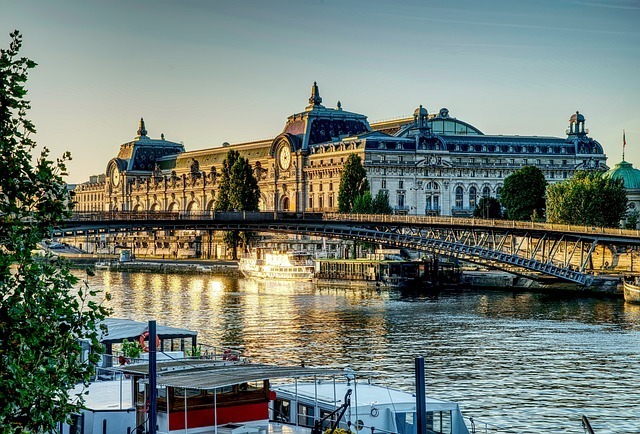
N6 – Must-Visit Landmarks in Paris – Musée d’Orsay
Housed in a former railway station, the Musée d’Orsay is a paradise for art enthusiasts. It boasts an unparalleled collection of Impressionist and Post-Impressionist masterpieces, showcasing works by Monet, Van Gogh, Degas, and more. The Musée d’Orsay in Paris is considered a must-visit for several reasons:
Impressive Art Collection:
The museum is renowned for its extensive collection of Impressionist and Post-Impressionist masterpieces. It houses works by iconic artists such as Claude Monet, Vincent van Gogh, Edgar Degas, Pierre-Auguste Renoir, and Paul Cézanne, among others. These artworks are significant in the history of art and provide a unique opportunity to witness the development of modern art movements.
Historic Architecture:
The museum building itself is a masterpiece of architecture. Housed in a former railway station, the Beaux-Arts-style structure offers a unique contrast between the historic iron and glass design of the station and the modern, carefully curated interior. This blend of history and contemporary design makes the visit to the museum itself an enriching experience.
Artistic Evolution:
The museum’s collection covers a crucial period in art history when traditional styles were giving way to new forms of artistic expression. The transition from Realism to Impressionism and then to Post-Impressionism is vividly represented in the artworks on display. This journey through different artistic movements allows visitors to witness the evolution of art during a transformative era.
Cultural Significance:
The Impressionist movement represented a significant shift in how art was perceived, created, and appreciated. The works displayed at the Musée d’Orsay played a pivotal role in shaping the modern art landscape and continue to inspire artists and art enthusiasts alike.
Diverse Mediums:
The museum’s collection includes not only paintings but also sculptures, decorative arts, photography, and more. This diversity provides visitors with a comprehensive overview of the artistic output of the time, showcasing different mediums and techniques that were being explored during the period.
Atmosphere and Setting:
The museum’s layout and ambiance contribute to a unique and immersive experience. The spacious galleries and natural lighting allow visitors to view the artworks in a comfortable and visually pleasing environment.
Educational and Inspirational:
Whether you’re an art connoisseur or a casual visitor, the Musée d’Orsay offers an educational and inspirational experience. Learning about the artists, their lives, and the historical context of their works can deepen your understanding and appreciation of art.
Central Location:
The museum is conveniently located in the heart of Paris, making it easily accessible and a perfect addition to your Parisian itinerary. Its proximity to other landmarks and attractions also makes it a convenient stop during your exploration of the city.
The Musée d’Orsay is a must-visit in Paris because of its outstanding collection of Impressionist and Post-Impressionist art, its historic architecture, its role in shaping art history, and the unique experience it offers to visitors interested in art and culture.
View and Book: Paris: Musée d’Orsay 1-Day Ticket with Reserved Access
7. Palace of Versailles: Regal Extravaganza
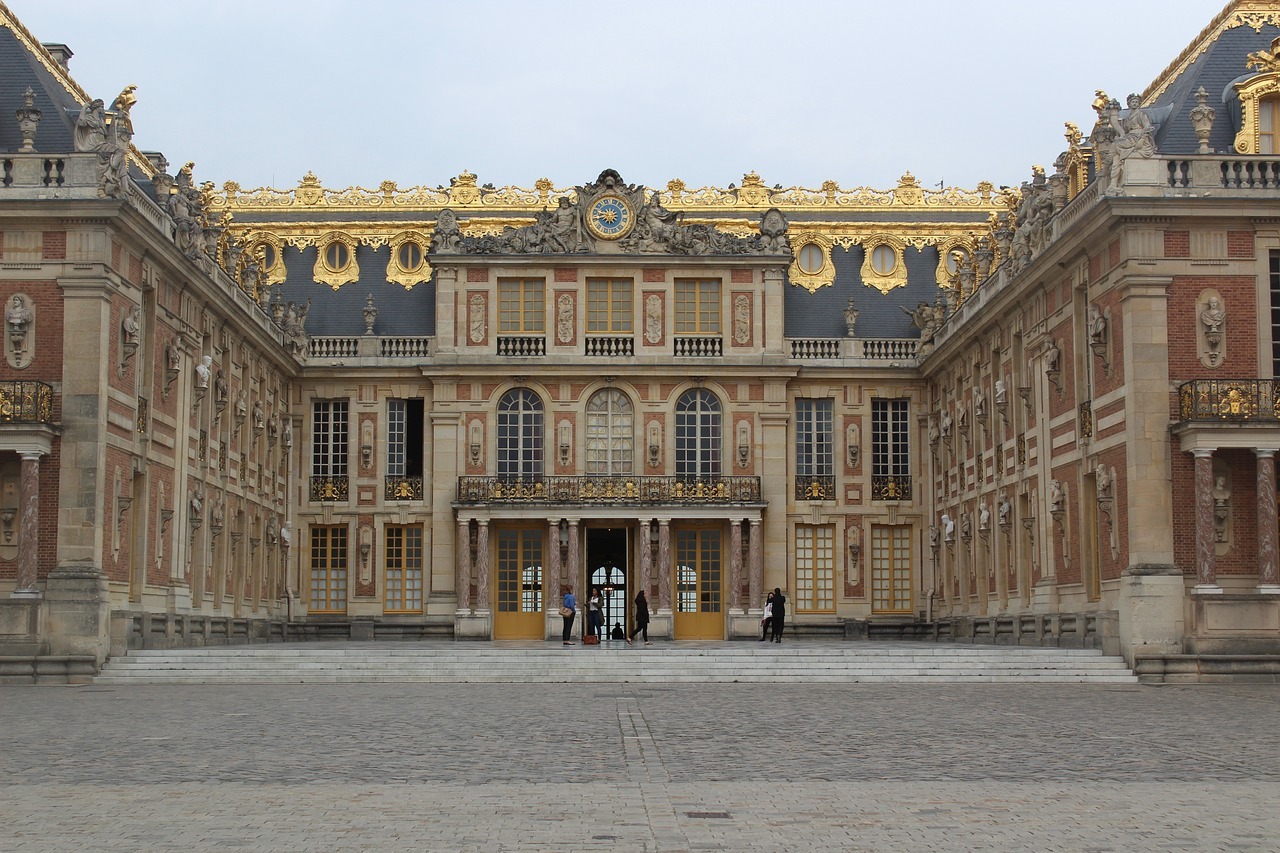
N7 – Must-Visit Landmarks in Paris – Palace of Versailles
While not in the heart of Paris, a visit to the Palace of Versailles is a short trip away and well worth it. The opulent palace, stunning gardens, and Hall of Mirrors offer a glimpse into the lavish lifestyle of French royalty. The Palace of Versailles is considered a must-visit attraction near Paris for several reasons:
Historical Significance:
The Palace of Versailles is a symbol of the French monarchy’s power and opulence. It was originally a hunting lodge before Louis XIV transformed it into a magnificent palace in the 17th century. It served as the royal residence until the French Revolution, making it a site of great historical importance.
Architectural Marvel:
The palace is renowned for its stunning architecture, intricate details, and grandeur. The Palace of Versailles features a unique blend of Baroque and Rococo styles, characterized by its lavish decorations, grand facades, and beautifully landscaped gardens.
Hall of Mirrors:
One of the most famous features of the palace is the Hall of Mirrors (Galerie des Glaces). This grand gallery is adorned with 17 mirrored arches that reflect the natural light from the garden-facing windows. It was here that significant historical events, such as the signing of the Treaty of Versailles in 1919, took place.
Lavish Interiors:
The interior of the palace is filled with lavish rooms and apartments that showcase the luxurious lifestyle of the French monarchy. Visitors can explore the King’s Grand Apartments, the Queen’s Apartments, and various chambers, each decorated with exquisite art, sculptures, and furnishings.
Expansive Gardens:
The Palace of Versailles boasts sprawling, meticulously landscaped gardens designed by André Le Nôtre. The gardens feature geometrically designed lawns, ornate fountains, grand pathways, and sculptures. Visitors can enjoy leisurely strolls, rent rowboats on the Grand Canal, and witness impressive fountain displays during certain times of the year.
Cultural Significance:
The palace has played a significant role in shaping European art and culture. Its influence on architecture, interior design, and landscaping can be seen in various structures and gardens around the world.
UNESCO World Heritage Site:
In 1979, the Palace of Versailles was designated as a UNESCO World Heritage Site, recognizing its historical and cultural significance on a global level.
Day Trip from Paris:
The palace is conveniently located just a short train ride away from Paris, making it an accessible day trip option for visitors to the city.
Educational Opportunities:
The Palace of Versailles offers insights into French history, monarchy, and court life. Visitors can learn about the lives of the kings, queens, and nobles who once inhabited the palace.
The Palace of Versailles offers a glimpse into a bygone era of extravagance and power, making it a captivating destination for history enthusiasts, art lovers, and anyone interested in exploring the cultural heritage of France.
View and Book: Paris: Versailles Palace and Gardens Full Access Ticket
8. Seine River: A Romantic Must-Visit Landmarks in Paris
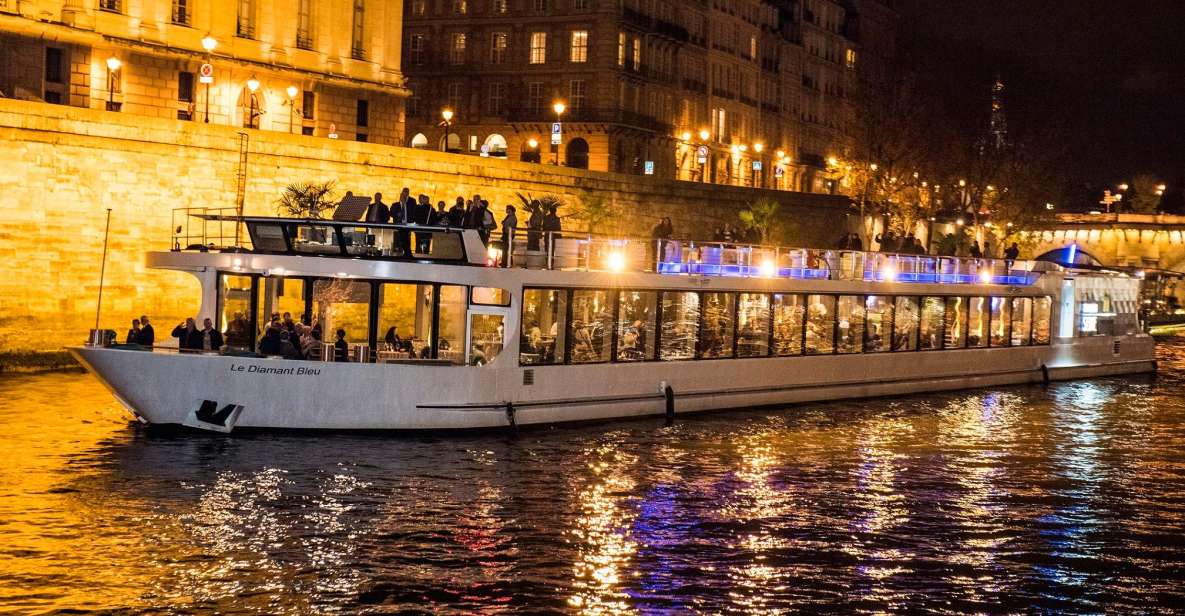
N8 – Must-Visit Landmarks in Paris Seine River
The Seine River winds its way through Paris, providing a romantic backdrop to the city’s landmarks. Embarking on a Seine River cruise is a serene way to take in sights like the Louvre, Notre-Dame, and the Eiffel Tower. Here are some reasons why the Seine River is highly recommended for visitors to Paris:
Iconic Landmarks:
The Seine River flows through the heart of Paris, passing by many iconic landmarks such as the Eiffel Tower, Notre-Dame Cathedral (before the fire in 2019), the Louvre Museum, Musée d’Orsay, and many more. Taking a boat cruise along the Seine allows you to see these famous sites from a unique perspective.
Romantic Atmosphere:
The river’s picturesque setting, with its charming bridges, historic buildings, and tree-lined banks, creates a romantic ambiance that has been celebrated in literature, art, and film for centuries. Many couples find the Seine River a perfect spot for romantic strolls or boat rides.
Historical Significance:
The Seine River has played a pivotal role in the history of Paris. It served as a natural barrier, contributing to the city’s defense strategy in medieval times. The construction of bridges and quays along the riverbanks played a vital role in the urban development of Paris.
Boat Cruises:
Taking a boat cruise along the Seine is a popular way to experience the city’s landmarks. Cruises often come with commentary in multiple languages, providing historical and cultural insights about the sites you’re passing. The nighttime cruises are especially enchanting as the illuminated buildings create a magical scene.
Photography Opportunities:
The Seine River offers numerous vantage points for stunning photographs of Paris. Whether you’re capturing the Eiffel Tower’s reflection in the water or the city’s charming bridges, you’ll find plenty of Instagram-worthy shots.
Cultural Experience:
The Seine River has inspired countless artists, writers, and musicians over the years. Strolling along the riverbanks, you’ll encounter bookstalls, street performers, and artists, contributing to the cultural vibrancy of the city.
Relaxation and Recreation:
The riverbanks provide tranquil spaces for locals and visitors to relax, have a picnic, or simply enjoy the views. Many Parisians and tourists alike take leisurely walks or sit by the river to unwind.
Connecting Neighborhoods:
The Seine River divides Paris into its Left Bank (Rive Gauche) and Right Bank (Rive Droite), each with its own distinct character and neighborhoods. Exploring both sides of the river offers a comprehensive view of the city’s diversity.
Historic Bridges:
Paris is known for its elegant bridges that span the Seine, each with its own architectural style and history. Walking across these bridges is a delightful way to explore the city on foot.
Cultural Events:
The Seine River hosts various cultural events throughout the year, such as outdoor concerts, art exhibitions, and festivals. These events contribute to the lively atmosphere along the riverbanks.
In essence, the Seine River is not only a waterway that flows through Paris; it’s a symbol of the city’s charm, history, and artistic spirit. Whether you’re admiring the architecture, enjoying a leisurely boat ride, or simply taking in the views, the Seine River offers a quintessential Parisian experience.
View and Book: Paris: 1-Hour River Seine Cruise
9. Montparnasse Tower: Skyline Vista
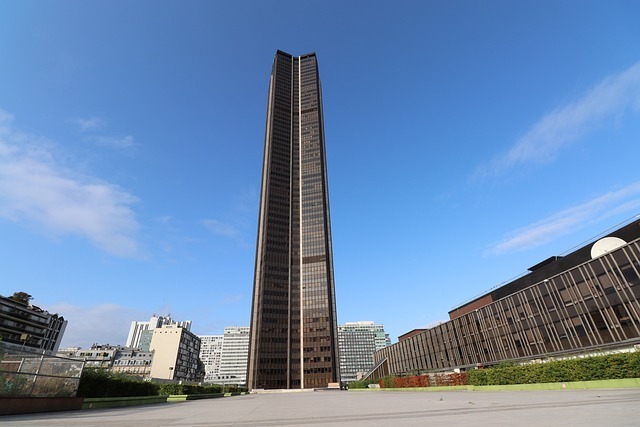
N9 – Must-Visit Landmarks in Paris Montparnasse Tower
The Montparnasse Tower in Paris is not often considered a “Must-Visit Landmarks in Paris” attraction compared to some of the more iconic landmarks like the Eiffel Tower, Louvre Museum, Notre-Dame Cathedral, and others. However, it does offer a unique perspective of the city and has its own merits that might make it appealing to certain visitors. Here are a few reasons why some people might consider Montparnasse Tower worth a visit:
Panoramic Views:
Montparnasse Tower provides an impressive panoramic view of Paris from its observation deck. Since it’s located in the Montparnasse district, you get an unobstructed view of the city’s famous landmarks, such as the Eiffel Tower, Sacré-Cœur Basilica, and more. Some visitors prefer this view because the tower itself is not part of the skyline, so you can see the skyline with the iconic Eiffel Tower in it.
Fewer Crowds:
Unlike some of the more popular attractions in Paris, Montparnasse Tower tends to be less crowded. This can be appealing to visitors who want to enjoy a more relaxed experience without the hustle and bustle of larger tourist spots.
Photo Opportunities:
The tower’s observation deck offers ample opportunities for photography. If you’re a photography enthusiast, you might find the different perspective and lighting conditions from Montparnasse Tower to be quite appealing for capturing stunning shots of the city.
Sunset Views:
The tower’s observation deck can offer breathtaking sunset views over Paris. Watching the sun set behind the iconic landmarks can create a memorable and romantic experience.
Alternative Experience:
While the Eiffel Tower is undoubtedly the most famous spot for panoramic views in Paris, some travelers prefer exploring lesser-known viewpoints for a more unique experience. Montparnasse Tower provides an alternative perspective that might be appreciated by those seeking something different.
It’s important to note that opinions on what constitutes a “must-visit” attraction can vary greatly depending on individual preferences and interests. If you have a strong interest in architecture, city views, and a quieter atmosphere compared to some of the more crowded tourist spots, then a visit to Montparnasse Tower could be a worthwhile addition to your Paris itinerary.
View and Book: Paris: 1.5-Hour Guided Walking Tour of Montparnasse
10. Palais Garnier: Opulent Opera House
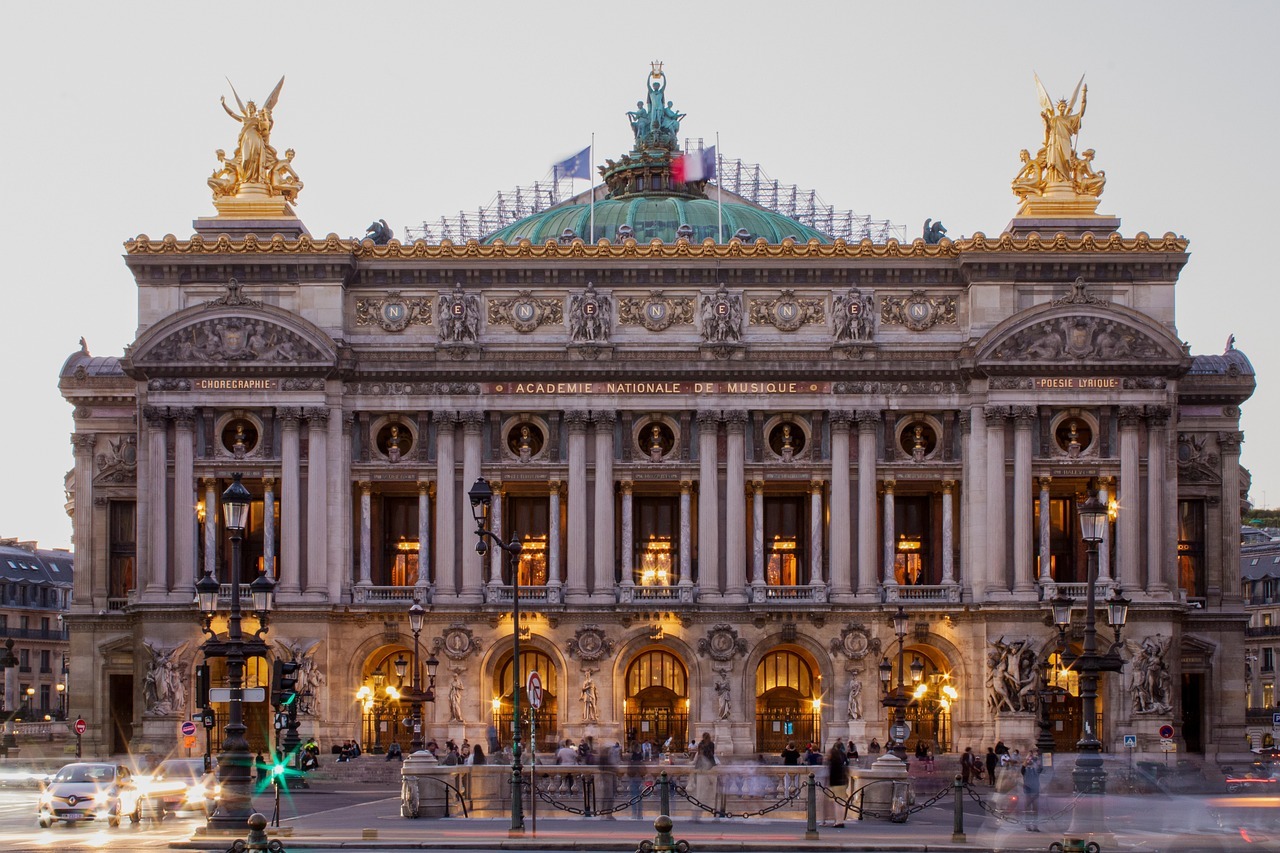
N10 – Must-Visit Landmarks in Paris – Palais Garnier
The Palais Garnier, also known as the Opéra Garnier or simply the Paris Opera House, is considered a must-visit in Paris for several reasons:
Architectural Masterpiece:
The Palais Garnier is an architectural marvel designed by Charles Garnier and completed in 1875. Its opulent and ornate design reflects the grandeur of the Second Empire style, characterized by its lavish decorations, grand staircases, intricate mosaics, and beautiful sculptures. The stunning facade and interior details make it a feast for the eyes and a testament to the artistic and architectural prowess of its time.
Cultural Significance:
The opera house has played a crucial role in French cultural history. It has hosted numerous legendary performances by some of the world’s most renowned artists, musicians, and opera singers. It continues to be a hub for operatic and ballet performances, showcasing the city’s deep-rooted appreciation for the arts.
Historical Context:
The construction of the Palais Garnier was part of the transformation of Paris during the Second Empire under Napoleon III. It was intended to showcase the city’s cultural sophistication and the emperor’s commitment to fostering the arts. The opera house stands as a symbol of this period in Parisian history.
Breathtaking Interiors:
The interior of the Palais Garnier is a visual spectacle. The grand foyer, the auditorium with its famous chandelier, the Marc Chagall-painted ceiling, and the various lounges and salons are all exquisitely adorned with lavish decorations, rich fabrics, and intricate details. Visitors are often left awestruck by the sheer beauty and elegance of the space.
Phantom of the Opera Association:
The Palais Garnier’s connection to literature and pop culture adds to its allure. Gaston Leroux’s novel “The Phantom of the Opera” was set in this opera house, which has contributed to its mystique and fame. Fans of the novel and its adaptations often seek out the opera house to experience the setting firsthand.
Guided Tours:
The opera house offers guided tours that provide visitors with insight into its history, architecture, and behind-the-scenes areas that are typically not accessible during performances. These tours offer a unique opportunity to explore the hidden gems of the building and learn about its rich heritage.
Aesthetic Experience:
Even if you’re not a devoted fan of opera or ballet, the Palais Garnier offers a sensory experience that transcends its performances. The opulent surroundings and the sense of being transported to a bygone era make it a memorable destination for anyone interested in art, history, and culture.
For these reasons, the Palais Garnier stands as a must-visit destination in Paris, offering a glimpse into the city’s artistic heritage, architectural achievements, and cultural significance.
View and Book: Paris: Opera Garnier Entry Ticket
In conclusion, Paris is a city where every corner tells a story, and every landmark has a significance that has shaped its identity. Exploring these 10 must-visit landmarks will allow you to immerse yourself in the beauty, history, and culture of the City of Lights, creating memories that will last a lifetime.
Must-Visit Landmarks in Paris FAQs:
What is the significance of the Eiffel Tower in Paris?
The Eiffel Tower is an iconic iron lattice structure that stands as a timeless symbol of Paris. It offers breathtaking views from its observation decks and is a masterpiece of architectural engineering.
What makes the Louvre Museum a must-visit landmark?
The Louvre Museum houses a vast collection of art and history, including famous works like the Mona Lisa and Winged Victory of Samothrace. It’s the world’s largest art museum and offers a journey through human creativity.
Why should I visit Notre-Dame Cathedral in Paris?
Notre-Dame Cathedral is a blend of historical significance, architectural marvel, and cultural resonance. It’s a masterpiece of Gothic architecture and offers a unique experience that captures Paris’s essence.
What’s special about Sacré-Cœur Basilica on Montmartre?
The Sacré-Cœur Basilica offers panoramic views of Paris from its hilltop location. Its distinctive Romanesque and Byzantine architecture, along with the artistic ambiance of the Montmartre district, make it a unique and must-visit landmark.
What is the historical importance of the Arc de Triomphe?
The Arc de Triomphe symbolizes France’s history, resilience, and grandeur. It stands as a testament to the triumphs and challenges that have shaped the country. Visiting the Arc de Triomphe gives insight into Parisian heritage.
Why is the Musée d’Orsay a paradise for art enthusiasts?
Housed in a former railway station, the Musée d’Orsay is known for its unparalleled collection of Impressionist and Post-Impressionist masterpieces by artists like Monet and Van Gogh.
What makes the Palace of Versailles a regal extravaganza?
The Palace of Versailles offers a glimpse into the opulent lifestyle of French royalty. Its lavish palace, stunning gardens, and Hall of Mirrors are highlights that showcase the grandeur of the past.
Why is the Seine River considered romantic and significant?
The Seine River flows through Paris, offering a romantic backdrop to iconic landmarks. Boat cruises provide a unique perspective of the city, historical insights, and stunning photography opportunities.
Why might I consider visiting Montparnasse Tower in Paris?
While not as iconic as some landmarks, Montparnasse Tower provides a distinct view of the Paris skyline. It offers a unique perspective and can be appealing for those seeking a different vantage point.
What makes the Palais Garnier a must-visit opera house?
The Palais Garnier, also known as the Paris Opera House, is renowned for its opulent architecture and rich history. It’s a cultural gem that offers a glimpse into Paris’s artistic heritage.












